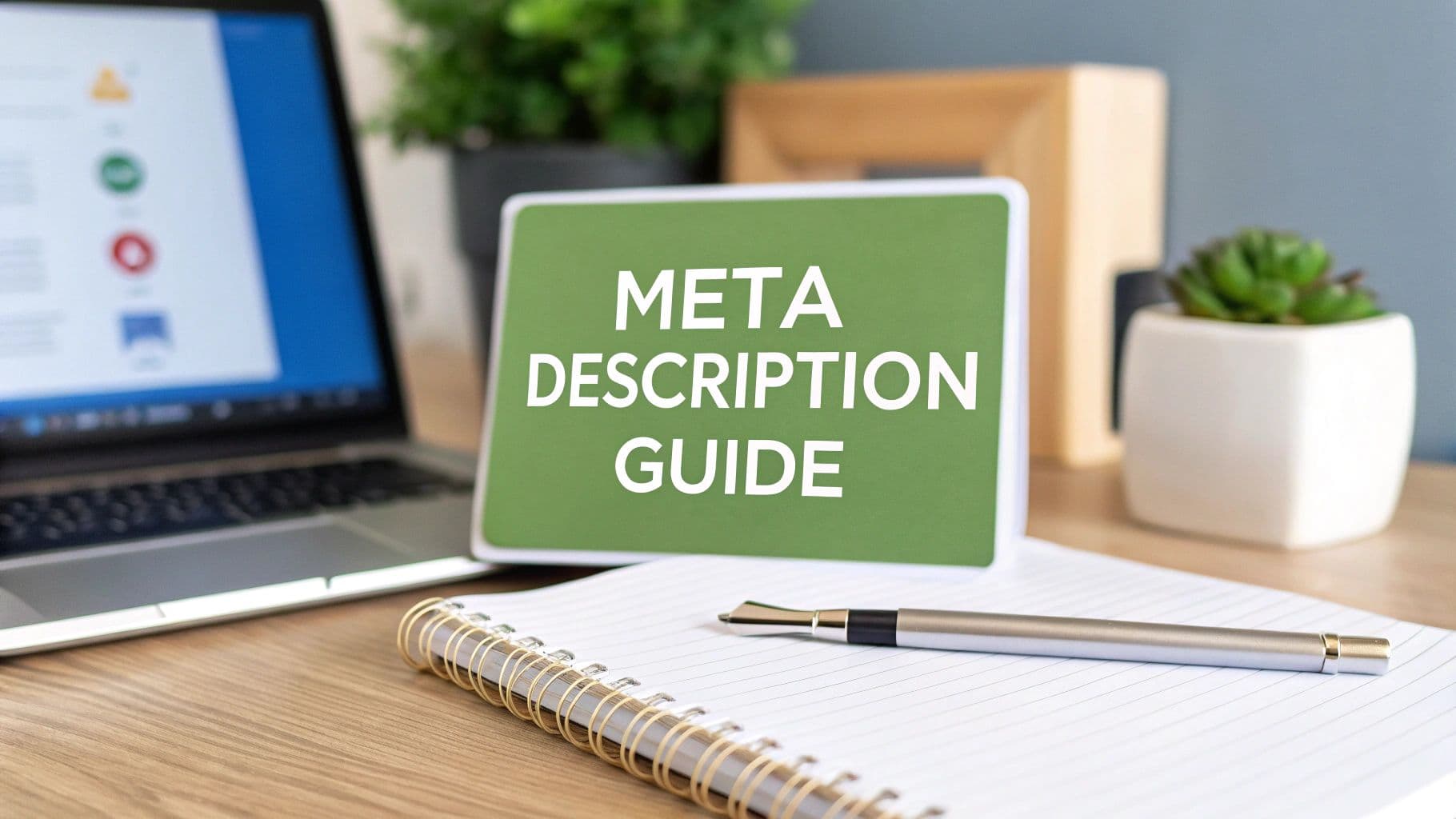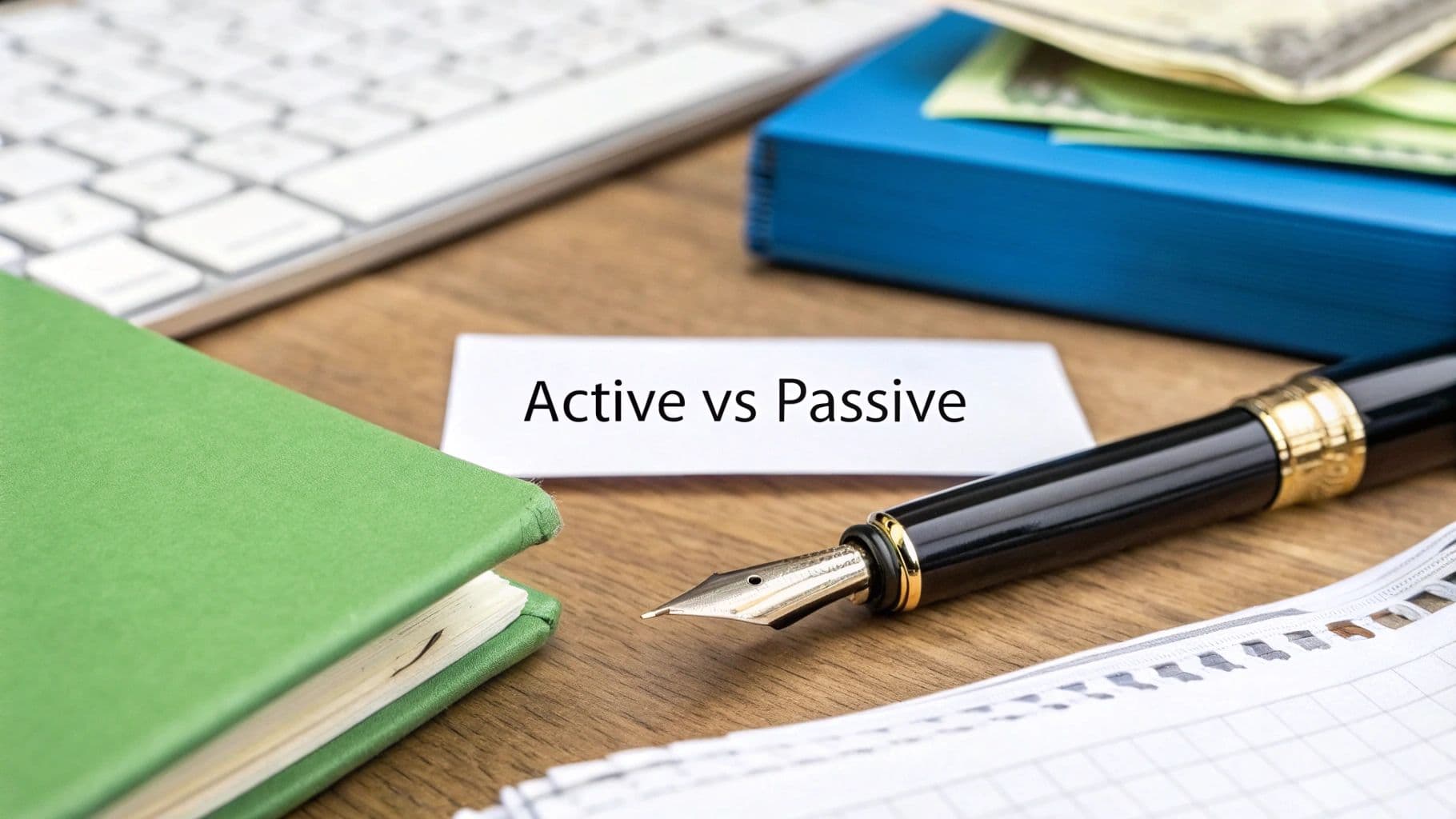
How to Write Meta Descriptions That Get Clicks
September 27, 2025
When it comes to writing meta descriptions, think of it less like a technical SEO task and more like crafting compelling ad copy. Your goal is to summarize exactly why a searcher should click on your page, making it the obvious choice among a sea of competitors.
So, Do Meta Descriptions Still Matter in 2025?
Let's be real—a lot of SEO pros treat meta descriptions as an afterthought. It's an easy trap to fall into, especially since Google has been clear that they don't directly impact your rankings. But thinking that way means you’re missing the bigger picture.
Your title tag is the headline that grabs a searcher's attention, but the meta description is what seals the deal. It's your one shot to pitch your content and convince them you have the answer they're looking for.
This tiny snippet of text has a huge, measurable impact on your site's performance, primarily by:
- Boosting Click-Through Rate (CTR): A great description is pure persuasion. It acts like ad copy, convincing users that your page is the best result for their query.
- Setting the Right Expectations: It gives users a clear preview of what’s on the page. When they know what to expect, they're more likely to stick around, which helps lower bounce rates.
Here’s a quick look at how a search snippet, which pulls from your meta description, appears on the results page.
You can see how the title, URL, and description all have to work together to earn that click.
Even now, their role is as critical as ever. Recent data shows that around 75% of top-ranking websites use a well-written meta description. This leaves a massive opportunity for anyone willing to learn how to optimize content for SEO.
If you want to dive deeper into where meta descriptions fit into a broader strategy, check out this fantastic ultimate small business SEO guide.
What Goes Into a Meta Description That Actually Gets Clicks?

Ever wonder what separates a meta description that gets totally ignored from one that people can't help but click? It’s not some dark SEO magic. It’s about understanding the core components that make a description compelling.
Think of it as your page's mini-advertisement right on the SERP. The best ones are clear, concise, and immediately answer the searcher's unspoken question: "What's in it for me?" This is less about stuffing keywords and more about crafting a persuasive, value-driven message.
Find the Sweet Spot for Length
Getting the length right is a balancing act. Too short, and you’re leaving prime real estate on the table. Too long, and Google will chop it off with an ellipsis (...), killing your message mid-sentence.
While the old hard-and-fast rule was 160 characters, things have changed. These days, the sweet spot is around 100-155 characters. This gives you enough room to be descriptive and compelling without getting cut off. For the nitty-gritty, you can always check out Google's official documentation for snippets.
Weave in Your Primary Keyword
This one’s a must. You need to include your main keyword, but it has to feel natural. When someone searches for that term, Google bolds it in the search results, which instantly draws their eye to your listing.
So, if your article is about "beginner indoor plants," that exact phrase should be in your description. Don't go overboard and repeat it—one clean, natural placement is all it takes to get that little visual boost.
Key Takeaway: Your meta description has one job: earn the click. It needs to be an honest preview of your content and clearly show the reader what they'll gain, all while playing within the character-count sandbox.
Speak Directly to Your Audience
Using an active voice is one of the easiest ways to make your writing more powerful. It’s direct, it’s engaging, and it works.
Instead of a passive, boring statement like, "The best techniques for meta descriptions are explained here," flip it. Try something active like, "Discover the techniques you need to write meta descriptions that drive clicks." See the difference? One is a description, the other is a command—a call to action that puts the user in the driver's seat.
To pull it all together, here’s a quick breakdown of the core elements that every effective meta description should have.
Key Elements of an Effective Meta Description
| Element | Best Practice | Why It Matters |
|---|---|---|
| Optimal Length | Aim for 100-155 characters to avoid truncation in search results. | Ensures your full message is visible, preventing awkward cut-offs that confuse users. |
| Primary Keyword | Include your main target keyword once, naturally, early in the description. | Google bolds the matching search term, making your snippet stand out on the SERP. |
| Active Voice | Start with a strong action verb (e.g., "Learn," "Discover," "Get"). | Creates a more direct and compelling message that encourages the user to take action. |
| Value Proposition | Clearly state the benefit. What problem does your content solve? | Answers the user's "What's in it for me?" question, giving them a reason to choose your link. |
| Call-to-Action (CTA) | End with a clear, gentle nudge like "Learn more," "Read our guide," or "See how." | Explicitly tells the user what to do next, increasing the likelihood of a click. |
| Uniqueness | Write a unique description for every single page on your site. | Avoids duplicate content issues and ensures each snippet is tailored to the specific page content. |
Mastering these elements is the key to turning your meta descriptions from simple text snippets into powerful click-generating assets for your content.
Writing a Meta Description From Scratch
Alright, let's move from theory to practice. Writing a great meta description is less about following a rigid formula and more about getting inside the head of the person searching. It’s your one chance to connect with them on a crowded search results page.
The whole process really boils down to one simple question: what is the searcher actually looking for? We call this search intent. Are they trying to buy something, learn how to do something, or just find a quick answer? Nailing this is the first and most critical step.
Start With Search Intent and a Peek at the Competition
Before you even think about writing, pop open a new browser window and search for your target keyword. Seriously, do it. For our example, let's use "best indoor plants for beginners."
What pops up? The results are a goldmine of information, showing you exactly what people want and what Google already considers a good answer.
Take a look at the top-ranking meta descriptions. Are they mostly listicles ("12 Easy-to-Care-For Plants…")? How-to guides ("How to Pick Your First Houseplant…")? Or are they e-commerce pages? This quick competitive analysis tells you what's currently winning clicks. Your job isn't to copy them, but to spot a gap or find an angle that makes your page the obvious choice.
Pro Tip: Don't just scan what your competitors are saying—pay attention to how they're saying it. Is the tone helpful and friendly? Do they use numbers or symbols to grab your eye? These little details are often what make one result more clickable than another.
The infographic below really drives home the point that every single word matters when you’ve got such limited real estate.

It’s a great visual reminder that you need to be clear and concise to make a real impact.
Drafting a Description That Clicks
Okay, let's draft a description for our "best indoor plants for beginners" page. We know the user is probably a bit nervous about killing their first plant. They want something easy and forgiving. Our description needs to deliver that promise immediately.
Here’s a first pass:
- V1: This article is about the best indoor plants for beginners. We list several plants that are good for people who don't have a lot of experience with plants.
Sure, it's accurate. But it’s also boring and passive. It won't stand out. Let’s try that again with a little more energy and a focus on the user's benefit.
- V2: Discover the 10 best indoor plants for beginners that anyone can keep alive. Find low-light, easy-care houseplants to brighten your home today.
See the difference? This version is much stronger. It starts with an action-oriented verb ("Discover"), sets a clear expectation with a number ("10 best"), highlights key benefits ("low-light, easy-care"), and wraps up with a gentle call-to-action ("brighten your home today").
This style of writing is far more engaging. If you want to get better at it, learning how to write conversationally will make a huge difference in all your copy, not just your metas.
Finally, give it a quick character count check. You want to stay within that sweet spot of 100-155 characters to make sure your brilliant copy doesn't get awkwardly truncated by Google.
Advanced Techniques to Make Your Snippet Stand Out
Okay, so you've nailed the basics. You know about character counts, keywords, and explaining what your page is about. That's a great start, but it's really just the price of entry.
If you want to truly stand out on a crowded search results page, you need to think less like a machine and more like a psychologist. Your goal is to craft a snippet that someone can't help but click.
Tap Into Psychological Triggers
Emotion is what drives clicks. Instead of just listing facts about your page, you need to make the searcher feel something.
Spark Curiosity: A great way to do this is by asking a direct question or dropping a surprising statistic that makes them hungry for the answer. Think along the lines of, "Are you making these three common SEO mistakes without even knowing it?"
Build Trust with Social Proof: Numbers create instant authority. A description like, "Join over 10,000 marketers who have already transformed their workflow with this guide," feels much more powerful than a simple list of what's inside.
Create a Sense of Urgency: Time-sensitive language gets people to act now. Phrases like "Find out before it's too late" or "Get the latest data for this year's trends" can provide that little push they need to choose your link over another.
These aren't just tricks; they're core principles of compelling communication. You can dive deeper into these ideas in our guide on persuasive writing techniques.
Win the Visual Battle with Rich Snippets
Sometimes, it's not just about the words—it's about the space you take up. This is where structured data comes in. It's the behind-the-scenes code that tells Google to show extra information, creating what we call "rich snippets."
You've seen them: the review stars, the product pricing, the FAQ dropdowns that make a search result bigger and more engaging.
I've seen firsthand how implementing structured data for reviews or FAQs can completely change the game. It can dramatically boost visibility and trust, often leading to a much higher click-through rate even if you aren't ranked number one.
The data backs this up. Studies, like this one from Search Engine Land, show that using an active voice and a clear call-to-action can lift CTR by up to 20-30%. Combining that with the visual pop of a rich snippet is how you truly start to dominate the SERPs.
Common Meta Description Mistakes to Avoid
Even seasoned pros can slip up and make simple errors that kill a meta description's performance. Knowing what not to do is just as crucial as following all the best practices. Let's walk through the most common pitfalls I see people fall into so you can sidestep them.

It’s easy to get lazy and write duplicate descriptions. Slapping the same generic snippet on every page feels efficient, but it's a huge missed opportunity. Each page on your site has a unique job to do, and it needs its own unique pitch on the search results page to match.
Then there's the classic mistake: keyword stuffing. Jamming your description full of keywords doesn't trick Google, it just makes your text sound robotic and desperate. People read these, and they can spot spam a mile away.
Here’s what that looks like in the wild:
- Bad Example: "Learn how to write meta descriptions with our meta description writing guide. Good meta descriptions are key for SEO meta descriptions."
- Good Example: "Ready to write meta descriptions that actually get clicks? Our guide breaks down the process with actionable tips and real-world examples."
See the difference? The second one speaks to a human.
Not Delivering on Your Promise
Think of your meta description as a promise. If you tell a searcher they'll find a "complete list of 25 tools" but your article only lists ten, you’ve broken that promise. This is classic clickbait, and it creates a terrible user experience.
When a user clicks your link and immediately hits the back button, it sends a strong signal to Google that your page isn't delivering. This is called a high bounce rate, and it can seriously hurt your rankings over time.
Key Takeaway: Honesty is always the best policy. An accurate description builds trust and keeps people on your page. A misleading one just damages your credibility.
Finally, the biggest mistake of all is just not writing one. If you leave the meta description field blank, you’re letting Google decide how to represent your page. It will often pull a random, clunky sentence from your content that does absolutely nothing to entice a click.
Taking a few minutes to write a custom description gives you control over that first impression. It’s a small effort with a massive payoff.
Answering Your Top Meta Description Questions
Once you start writing these in practice, a few common questions always seem to pop up. Let's get those cleared up so you can write with confidence. These are the little details that often separate a good meta description from a great one.
Does Google Always Use My Meta Description?
Nope, and this is a big one. It can be frustrating to craft the perfect description only to see Google show something completely different.
Google will often pull a different snippet from your page if it believes that text provides a better, more direct answer to a user's specific search. You'll see this happen a lot with long-tail or highly specific queries.
That said, don't skip writing them. A strong, relevant meta description has a much higher probability of being used. Think of it as putting your best foot forward—you’re giving Google your preferred message, and most of the time, they'll use it.
Are Emojis and Special Characters a Good Idea?
They can be, but you have to use them wisely. A strategically placed emoji or special character (like a checkmark ✅) can really make your result stand out on a crowded search page. They're great for catching the eye and adding a touch of personality.
The key is to not overdo it. If they don't align with your brand's voice, they can look spammy or unprofessional. Plus, they don't always show up correctly on every device. My rule of thumb? Test them. If it feels forced, leave it out.
My Advice: If your brand has a conversational or playful tone, one or two relevant emojis can work wonders. For a more corporate or serious site, you're usually better off sticking to powerful, clean text.
What’s the Difference Between a Meta Description and a SERP Snippet?
This is a classic point of confusion. Here’s the simple way to think about it:
- The meta description is what you write. It’s the specific piece of HTML code you add to your page's backend. You control this part.
- The SERP snippet is what Google actually shows in the search results.
Often, they're the same thing. But Google might decide to show a snippet pulled from your page's body content, a rich result with review stars, or another auto-generated blurb it thinks is a better fit for the search.
Getting your meta descriptions right takes a bit of practice, but so does polishing any piece of AI-generated content. For everything else, Natural Write can instantly humanize drafts from any AI writer, making sure your message sounds authentic and sails past AI detectors. Turn your robotic text into natural, engaging copy at https://naturalwrite.com.


